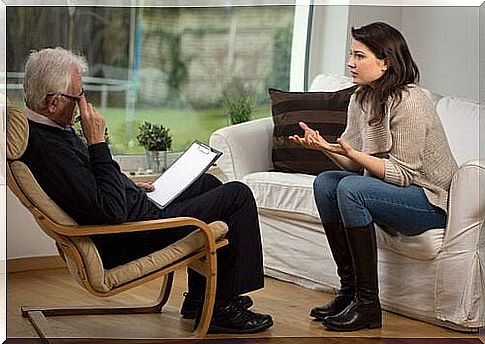What Does The Term Report Mean? Relationship Building Techniques

The word rapport comes from the French word rapporter, which means “to bring back”. The term report refers to the fact that one person sends a message and the other person returns it. Rapport is the connection between two or more people. It is also the psychological and emotional harmony needed to bring about changes in both individuals.
The relationship with the patient
During a patient’s treatment, things like the therapeutic approach, previous psychological evaluation, and techniques used during treatment are very important. This also applies to establishing a good relationship with the patient. They must trust you completely and take the treatment seriously.
Nothing else matters if you don’t have a good relationship with your patient. Because it can affect all the other variables. The patient may not come to the sessions or commit to treatment. He may not be motivated to change or trust what you say or suggest.
When we talk about the term rapport in the therapeutic sense, we mean that people have mutual understanding, are willing to cooperate, and have enough empathy to tackle a common problem and achieve desired goals. Today it is so important to teach future therapists about this. There are even specialized training courses on these subjects. They are addressed to various professional experts, especially in health care.
The origin of the term report
The concept of rapport or the idea of a therapeutic compound was developed in the course of the twentieth century. The psychoanalyst Sigmund Freud described in his 1912 work The Dynamics of Transference how in his view the analyst should have an interest and an understanding attitude towards the patient. The objective was for the healthy part of the patient to build a positive relationship with the analyst.

Freud described the patient’s affection for the therapist as a useful and positive form of transference. In psychoanalysis, transference is a psychological process through which the client transfers his unconscious thoughts and emotions to the other person, the therapist.
Freud thought that positive transference fostered trust, acceptance, and credibility in how the patient interprets the therapist. However, it was later discovered that it was not the transference that created this environment of trust and collaboration between the therapist and the patient. Sometimes this could lead to misunderstandings, which are obviously not positive.
Later on, the concept of rapport has been incorporated into most therapeutic approaches and has moved away from the idea of transference suggested by psychoanalysis.
The quality of the relationship
Carl Rogers is the father of humanistic psychology. According to him, it is essential to pay attention to the quality of the relationship between the therapist and the patient. Rogers identified three fundamental characteristics that the therapist must possess: compatibility (or authenticity), unconditional positive attention (or acceptance), and empathic understanding.
In the 1970s, Edward Bordin defined general characteristics that must be present in the therapeutic relationship. Bordin also identified three elements related to the concept of rapport that the patient and therapist must agree on: assignments, goals, and bond.
Techniques for developing a good report
The two fundamental pillars on which the concept of report is based are trust and fluid communication. The therapist and client must understand each other’s verbal and non-verbal communication. In addition, the communication must be asymmetrical. Because the patient must reveal more than the therapist.
Here are some effective techniques for developing a good report:
Active listening
This may seem like a simple technique. But it is often very difficult to actually achieve it. It involves listening to the patient without interrupting or forming value judgments. It also has to do with showing through gestures and expressions that you are on their side, by listening carefully, understanding what they mean, and showing empathy for their emotions.

Warmth
It is also important that you show warmth to the client so that a good report can arise, even if you know many useful techniques and have a lot of experience.
Because without warmth, the patient will not trust you or open up to you. He will also not reveal any important information. The lack of confidence will directly affect the patient’s commitment to treatment. This makes it less likely that he will use the techniques you suggest.
Empathy
Obviously, if you want to help them, you need to be able to put yourself in the other person’s situation. Moreover, it makes no difference whether the patient has a sensory disorder or has committed a crime. If you want to treat him, you have to see the world through their eyes. You should do this even if you don’t share their feelings or agree with their actions. The only way to build trust and help the person is to be empathetic.
To trust
It is important that the patient feels comfortable going to the therapy sessions. This is necessary to build trust in addition to all the other things you have to be and appear credible.
The patient must believe that you are a professional, that you are well trained and that you will do whatever it takes to provide them with the help they need. Possible ways to help are by referring them to another therapist or by training yourself in whatever they are suffering from. That way they will trust you.

Common Goals
As you develop rapport, try to focus on the things you have in common that will help you toward the client’s therapeutic goal. It is important that you do not slip and end up talking about common interests that have nothing to do with the objective. Because if you do this, you will be wasting time. In addition, the relationship will no longer be asymmetric.
Relationship between verbal and non-verbal language
Be careful when communicating with your patient. Because people often say things that contradict their expressions or gestures. The relationship between verbal and non-verbal language is fundamental to the therapeutic relationship. Without this coherence, you cannot create an environment of trust and cooperation.
So, as Rogers said, you need to appear authentic and genuine to your patient. Watch your attitude and maintain warmth, acceptance and empathy in your verbal and non-verbal communication.

What can you do if you fail to produce a good report?
These techniques may just seem like common sense. But it’s not so easy to put them into practice when you’re effectively working with a patient in your office. Because therapists are people too, with their own values, attitudes and emotions. Leave these elements at the door for the client to make progress.
Even if you still can’t build a good relationship with the client, don’t be disappointed. Just as you don’t always feel close to the people in your personal life, the same can happen in therapeutic relationships. This can happen even when you’ve tried your best to make sure it doesn’t happen.
In this case, the fairest thing you can do is refer the client to another therapist. That person may be able to develop a better therapeutic connection with the patient and resume the process of personal growth. That way neither of you will waste time. Moreover, you still strive for the common goal, the betterment of the patient.
References
Rogers, C. (1951). Client-centered therapy: Its current practice, implications and theory. London: Constable.
Corbella, S., Botella, L. (2003). The therapeutic commitment: history, research and evaluation. Public Service of the University of Murcia. ISSN: 0212-9728
Freud, A. (1936). The ego and its defense mechanisms. Vienna:Int. Psychoanal. decrease.









